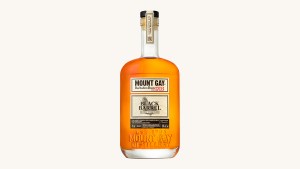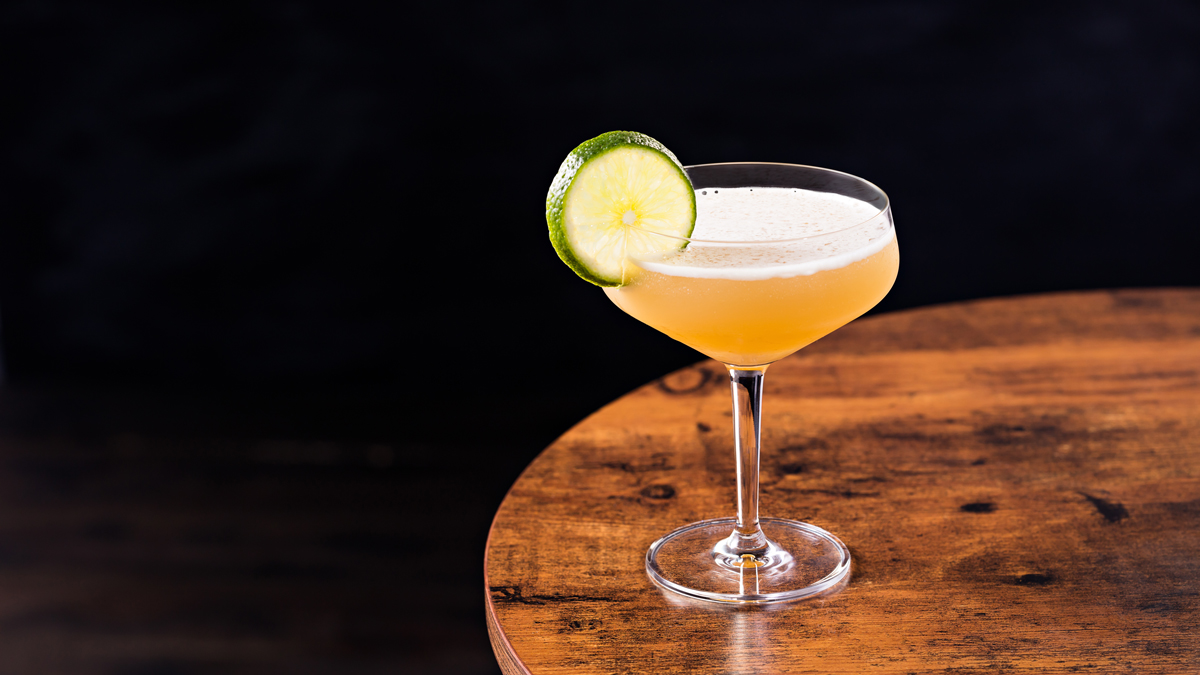The Royal Bermuda Yacht Club is not a tiki drink. Admittedly it sounds like one, and the recipe might even read a little like one, but it’s not—if you’re hoping for a juice-packed garnish monster, this is not the for you. No, in order to understand the Royal Bermuda Yacht Club cocktail, it helps to linger for a minute on its pedigree; it didn’t get its name because some lei- and orchid-festooned bartender in California thought it was a neat name for a drink, it got its name because it was invented at a Royal Yacht Club in Bermuda.
Bermuda, despite what the Beach Boys may try to tell you, is very much not part of the Caribbean. It’s 1,000 miles north of the Caribbean in fact, closer to the Carolinas than the Bahamas. It’s all alone out there in the Atlantic, over 600 miles of open ocean from anything at all and ringed with historically treacherous reefs, which we mention only to highlight that expertise in sailing is and has always been a huge part of life on the island.
In 1844, a group of 30 local sailors and British officers came together “under a calabash tree” to create an institution devoted to sailing and founded the Bermuda Yacht Club. Two years later, the club was granted a royal charter from Queen Victoria, making it the Royal Bermuda Yacht Club and granting it all the social cachet and honorable repute that crown recognition confers. It has existed this way for some 180 years: Hosting prestigious sailing regattas, running a sailing training academy, and providing a restaurant and event space for its more than 800 members.
It is here, presumably in the 1930s, that a writer from Harper’s Bazaar named Mary Mabon enjoyed a cocktail made from Barbados rum, falernum (a lime and spice liqueur), orange liqueur, and lime juice. The drink appears in the 1941 book Cocktail Guide and Ladies’ Companion by Crosby Gaige, in a chapter wherein Gaige asked famous friends for their favorite drinks, and he features Mabon’s selection, calling it “one of the best rum drinks on the island.” It’s unclear if the club named it after itself, or if the cocktail ever had a name at all,or if Gaige (as he was ) renamed it according to its own whims, but it nonetheless gets christened after the place it was from, and is immortalized as the Royal Bermuda Yacht Club Cocktail.
So why isn’t it a tiki drink? Well despite being later swept up in Trader Vic’s orbit (a big tiki guy) and despite using falernum (a big tiki ingredient), it’s not overly juicy or complicated, it doesn’t have 55 garnishes, and it doesn’t come in a mug shaped like an angry totemic demigod. The Royal Bermuda Yacht Club is clean, lithe, and snappy. Bermuda is an island, yes, and it’s warm, yes, but tiki bars are baroque, and the most baroque thing about the yacht club is the facial hair of the 19th century commodores whose black and white portraits stare solemnly out from the walls. The cocktail is not in any way embraced, endorsed, or underwritten by the club itself—their official website doesn’t mention it at all, nor do the various online reviews. They are about sailing there. This cocktail business seems beneath them.
They’re missing out. Done well, the Royal Bermuda Yacht Club Cocktail is bright and almost exuberantly refreshing. The lime and the rum speak for themselves, but where you’d expect to find the balancing sugar, the cocktail instead comes with the juicy zest of orange liqueur and the warm spice of falernum. Its association with the tiki world is not completely inappropriate—it’s a difference of degrees, not of kind, but it’s a lot of degrees. It’s a , essentially, with a hint of island patois, or a , if you must, but with a soldier’s posture and a pressed suit, which is about as tiki as a Royal Yacht Club in Bermuda would ever deign to be.
Royal Bermuda Yacht Club
- 1.5 oz. aged rum
- 0.25 oz. Cointreau
- 0.25 oz. falernum
- 0.25 oz. demerara syrup
- 0.75 oz. lime juice
Add ingredients to a cocktail shaker with ice and shake hard for 8 to 10 seconds. Strain up into a cocktail class or coupe and garnish with a lime wheel or peel.
NOTES ON INGREDIENTS

Mount Gay
Demerara Syrup: This cocktail’s big problem is depth: If you don’t use the right ingredients, it can be superficial and a little hollow. Many recipes call for many different ways to solve this (more on this below) but my favorite way is to add an ingredient in the form of demerara syrup. Demerara Sugar (or “turbinado” or “muscovado” or “Sugar in the Raw”) is sugar that is less refined than bleached white and so has some deep robust molasses notes to it, and for me, it’s the bit that solves both the sweetness problem and the depth problem in one go.
To make it, get some of the unrefined sugar and mix it in equal parts (½ cup to ½ cup, say) with hot water, and stir until it’s dissolved. The bigger the crystals of the sugar, the slower they dissolve—sometimes it’s better to do this in a small pot over a low heat, not to simmer, just until the crystals disappear. Within 5 minutes you’ll have a demerara syrup, which will last for a month in your fridge (and make your significantly better.)
Aged Rum: Bermuda doesn’t really grow sugar cane, so it never had a rum production of its own. Goslings rum is based there insofar as it is imported and blended there, so their Black Seal works if that’s what you’ve got, but I find Mabon’s original insistence on Barbados rum—particularly the soft aged spirits from Mt. Gay, like the Eclipse or Black Barrel—to be perfect.
What you want from the rum is to be soft and gently aged. Sometimes, for depth, an urge might be to grab a deep Demerara Rum or funky Jamaican rum, and that can work certainly, but I personally feel the depth problem is most elegantly and completely solved with a little rustic molasses from the sugar itself, and it’s easier to make a little extra syrup than buy a whole other bottle of rum.
Orange Liqueur: The original calls for “Cointreau or Brandy” which is weird, like a recipe calling for egg whites or egg yolks. Trader Vic wisely corrected this to a specific call for Cointreau, and that’s a good one. Cointreau is neutral spirit based (vodka, essentially). Many recipes call for curaçao or Grand Marnier which is brandy based (again, for depth) but the clean, juicy, zestiness of Cointreau or its chief rival Combier is what shines here for me. Curacao does indeed work, but it makes the whole thing heavier, and for me less elegant.
Falernum: Falernum is all over the place, but the one you’re most likely to find—and the one that seems to be category-defining—is John D. Taylor’s Velvet Falernum, which seems to have the right mix of lime, clove, and almond. It’s what I generally recommend. That said, there are some tasty N/A ones like Liquid Alchemist or B.G. Reynolds, though they tend to be a bit spice heavy and so will change the character of the drink.
Authors
-

Jason O’Bryan
Jason O’Bryan has set up a professional life at the intersection of writing and cocktails. He’s been managing cocktail bars for the last twelve years, first in Boston and now in San Diego, where he’s…
Credit: robbreport.com











